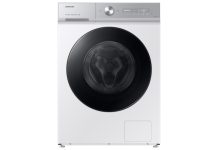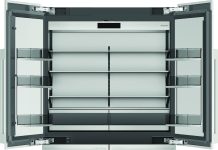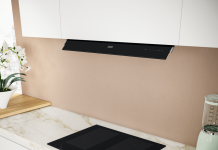Innovation that springs from collaboration: 3P, Faber and Ikea have developed a joint project where the protagonist is a new testing method to measure the suction efficiency of hoods with precise and repeatable modality.
Currently, this new parameter is neither considered by the regulation in force nor by the energy label. “To succeed in defining how to measure it – adds Usci -, we have carried out a research work that has started from the limits of the regulation itself. We have therefore examined some academic publications about the suction efficiency and we have adapted them to the requirements of manufacturers’ laboratories, so that the method could be easily executable and reproducible”.

The test chamber of the suction efficiency
To create the necessary testing set up for the suction efficiency test, 3P started from the chamber used for the measurement of the Odour Reduction Factor (i.e. the odour filtering efficiency) and has then considered and controlled the parameters on which depends how much pollutant is directly captured by the hood: the shape of the household appliance suction surfaces, the installation height close to the hob, the volumetric flow rate and the characteristics of the hob itself. “To execute the test – explains Usci – we position on the hob some pots with water that is brought to ebullition. When everything is in steady state (the water boils and then produces a fixed quantity of steam in time and the electrical power of the stove is stable, and therefore heating is constant), we use the technique of tracing gases (in this case CO2) “to colour” chemically the steam generated by pots». The measurement of the concentration of the tracing gas dispersed in the kitchen is executed in 16 points of the chamber, whereas a further sampling, downstream the hood, measures the concentration of tracing gas in the flow sucked by the hood itself. “The testing procedure – comments Usci – is very simple: once reached the stationary operation conditions of the hob and of the hood, a known constant quantity of tracing material (normalized at 100) is first introduced downstream the hood, artificially forcing the condition of 100% suction efficiency (all the pollutant produced by cooking is fully captured by the hood), then the same tracing flow is instantaneously deviated above the boiling water, chemically colouring the steam that ascends together with the thermal plume. From now onwards, are registered the two concentrations in environment and hood that compose the instantaneous suction efficiency, i.e. the portion of the pollutant produced by the hob directly intercepted by the hood”.
The tests carried out comparing a product optimized according to the suction efficiency with a non-optimized one show that, keeping the provided comfort unchanged, the first has minor flow rate and consequently lower energy consumptions and noise. “If the hood can intercept 100% of the pollutants coming from the hob – affirms Usci – it is useless to increase further the volumetric flow rate because in this way we consume more energy and especially we produce more noise”. “Until now – further explains Usci – the evaluation of the performances of a hood was mainly based on the value of the volumetric flow rate, then how much air the appliance sucks from the kitchen and how much it conveys outside. This is not a wrong approach but, with the suction efficiency, the product is further optimized. It is true that a more powerful motor (and then granting higher flow rates) purifies the kitchen faster but it is as true that we collect and convey outside this air of the kitchen that, maybe, we have heated in winter and conditioned in summer”.

Meeting consumers’ requirements
The project developed by 3P, Faber and Ikea aims at the common target of meeting the requirements of consumers wondering, beyond the aesthetical aspect of a hood, to what extent this appliance can really suck fumes. The measurement of the suction efficiency answers to this question with an objective testing protocol to measure this performance. Besides, if designed according to suction efficiency criteria, the hood can prevent the diffusion of odours in the kitchen. “The collaboration of Faber with 3P and Ikea – explains Francesco Faginoli, functional design manager, R&D Department Faber – is an innovative experience indeed, because it joins in a single project customer, supplier and technology subcontractor. Before undertaking this collaboration, we were already Ikea supplier and we were collaborating with this customer also for technical specifications and then new tests that could be relevant for the hood product. Hence the interest in the suction performance evaluation. We had thought of several methods to measure this performance type and finally we decided to collaborate with 3P, which was already one of our suppliers able to provide the suitable instruments for the suction efficiency measuring. We put in common the same experiences and, due to Ikea’s demand of measuring this parameter, we accomplished the process, defining a specific method for this kind of analysis”.
In this project, Faber technical division has worked in strict contact with Ikea for the implementation of technical solutions allowing the product feasibility in terms of required performance and design. “Ikea team defines the design and indicates the performances that hoods must have, then our engineers and designers take care of refining the project to make it technically feasible”.







